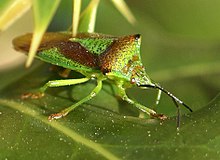Hemipteron
| Hemiptera Temporal range: Moscovian–Holocene, 307–0 Ma |
|
|---|---|
 |
|
| Acanthosoma haemorrhoidale, a shield bug | |
 |
|
| Aphids | |
| Scientific classification | |
| Kingdom: | Animalia |
| Phylum: | Arthropoda |
| Class: | Insecta |
| (unranked): | Paraneoptera |
| Superorder: | Condylognatha |
| Order: |
Hemiptera Linnaeus, 1758 |
| Suborders | |
The Hemiptera /hɛˈmɪptərə/ or true bugs are an order of insects comprising some 50,000 to 80,000 species of groups such as the cicadas, aphids, planthoppers, leafhoppers, and shield bugs. They range in size from 1 mm (0.04 in) to around 15 cm (6 in), and share a common arrangement of sucking mouthparts. The name "true bugs" is sometimes limited to the suborder Heteroptera. Many insects commonly known as "" belong to other orders; for example, the lovebug is a fly, while the May bug and ladybug are beetles.
Most hemipterans feed on plants, using their sucking and piercing mouthparts to extract plant sap. Some are parasitic while others are predators that feed on other insects or small invertebrates. They live in a wide variety of habitats, generally terrestrial, though some species are adapted to life in or on the surface of fresh water. Hemipterans are hemimetabolous, with young nymphs that somewhat resemble adults. Many aphids are capable of parthenogenesis, producing young from unfertilised eggs; this helps them to reproduce extremely rapidly in favourable conditions.
Humans have interacted with the Hemiptera for millennia. Some species, including many aphids, are important agricultural pests, damaging crops by the direct action of sucking sap, but also harming them indirectly by being the vectors of serious viral diseases. Other species have been used for biological control of insect pests. Hemipterans have been cultivated for the extraction of the dyestuff cochineal (also known as carmine) and for shellac. The bed bug is a persistent parasite of humans. Cicadas have been used as food, and have appeared in literature from the Iliad in Ancient Greece.
...
Wikipedia
